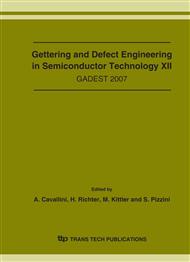p.175
p.183
p.189
p.195
p.201
p.207
p.213
p.219
p.225
Radiation Defects and Thermal Donors Introduced in Silicon by Hydrogen and Helium Implantation and Subsequent Annealing
Abstract:
The effect of high-energy hydrogen and helium implantation and subsequent annealing on generation of radiation defects and shallow donors in the low-doped oxygen-rich FZ n-type silicon was investigated. Samples were implanted with 7 MeV 4He2+ or 1.8 MeV 1H+ to fluences ranging from 1x109 to 3x1011 cm-2 and 1.4x1010 to 5x1012cm-2, resp., and then isochronally annealed for 30 minutes in the temperature range up to 550°C. Results show that radiation damage produced by helium ions remarkably enhances formation of thermal donors (TDs) when annealing temperature exceeds 375°C, i.e. when the majority of vacancy-related recombination centers anneals out. The excess concentration of TDs is proportional to the helium fluence and peaks at 1.6x1014cm-3 if annealing temperature reaches 475°C. Proton irradiation itself introduces hydrogen donors (HDs) which form a Gaussian peak at the proton end-of-range. Formation and annealing of shallow and deep hydrogen-related levels are strongly influenced by electric field at annealing temperatures below 175°C. If annealing temperature exceeds 350°C, HDs disappear and the excessive shallow doping is caused, as in the case of helium irradiation, by radiation enhanced TDs.
Info:
Periodical:
Pages:
201-206
Citation:
Online since:
October 2007
Authors:
Keywords:
Price:
Сopyright:
© 2008 Trans Tech Publications Ltd. All Rights Reserved
Share:
Citation:


